| Lista Light |  |
Sint Maarten
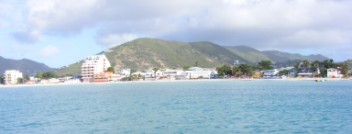
We were not really ready for Sint Maarten… after thirty days at sea, with nothing but a Tropic Bird and a Minke whale to keep us company, our fragile sensibilities were smashed by six cruise ships, yellow hard hat bedaubed formations of ‘segway’ riders, shops…cars.. people.. noise……
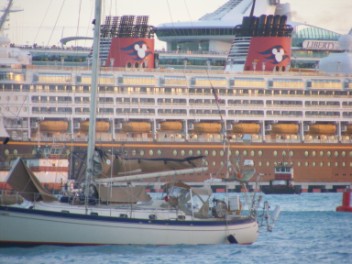
We had arrived in Philipsburg the capital of jet-skiers, power boaters, party boaters, fried tourists, ‘Macki-dees’, not really what we had sailed over three thousand miles to discover. In fact, what we had stumbled across was a living geography case study of how mass tourism can ruin a country.
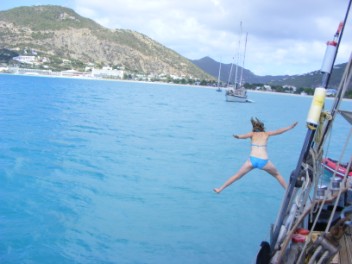
After weeks at sea (30 days) we fulfilled the quintessential sailors’ duties and headed for the nearest bar. All aboard the dinghy we rolled into Philipsburg and sitting by the sea devoured beers and rum. Dave and I managed to get hold of my Mum and sister and I crumpled into a blithering wreck on hearing their voices. Determined to celebrate in style Dave marched us back to the dinghy for full champagne salute aboard Lista. At the pontoon we met the crew from the Disney Cruise ship, an odd bunch- but then I’m not sure the four Brits who greeted them were exactly savory. Dan overcome with it all, stripped off and dived into the sea!
Aboard Lista more diving into an azure sea ensued, after which we were greeted by a rather odd view of Dave standing (a.k. Jesus) on water! Hmm… had we really consumed that many beers? Apparently not, it seemed that a huge solid plastic pipe had risen out of the water and provided the perfect perch for captain. (The pipe was used to move sand from the bay to seed the beech and rose to the surface during operation hours) Unfortunately, no one warned us of this on arrival in Philipsburg and at 6am the following morning we awoke to the monstrous pipe knocking against Lista’s hull.
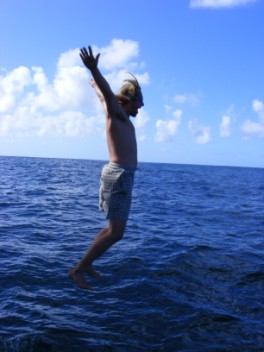
In the evening we ventured back into town for more celebrations and discussion of our momentous voyage. We talked long into the night about what we had learned and experienced together. We chatted to a local who remembered ‘winkies’ (fire flies) in the bay, when there was only a sand track along the beachfront. That was only thirty years ago, long enough for Sint Maarten to have had a facelift: for trees to have been felled, lagoons to have been in-filled and polluted, beaches seeded and bay dynamics altered.
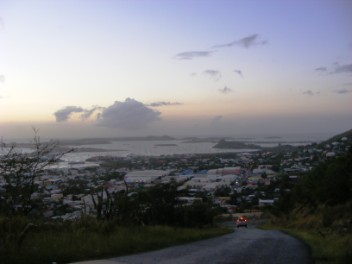
The ecosystem of Sint Maarten like other Lesser Antilles islands (and many islands in the world) did not evolve with mammals. Birds took the mammalian niches. When the first humans arrived over 7000 years ago they introduced mammals (goats, pigs, dogs etc) from the mainland that either preyed directly on seabirds or indirectly by altering the habitat that seabirds depended upon for nesting. The settlers also enjoyed the ready meal of seabirds, eggs and chicks. European colonists added to the volley of threats introducing rats and then mongooses. The mongoose like so many bio-control debacles repeated the world over proved to be a huge mistake. Mongooses preferred seabird eggs and chicks to the snakes and rats that they were intended to consume.
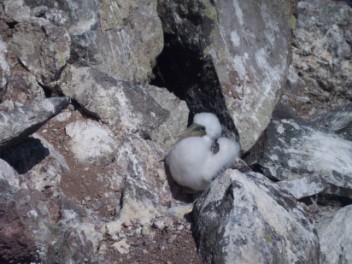
In recent years, the Sint Maarten islanders have abandoned the sea and the land for the new ‘catch’ of sweaty Westerns. Incredibly these newcomers do not appear to worry about frying by the side of a bulldozer or swimming in raw sewage pumped out by hotels. The worry is that should this fickle breed decide that Sint Maarten is too dangerous or passé, they will disappear leaving the island paralysed, unable to rekindle its original economy.
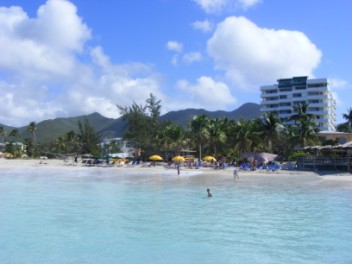
Ecology wise, things are desperate. Resident and migratory wading birds depend upon Sint Maarten’s saline lagoons for feeding and nesting. Unfortunately, these habitats have systematically been filled in for housing, roads and more recently a dump. Incredible! Contamination of water-bodies by raw sewage, toxins from rubbish, spills by yachts and powerboats have all added to the mix of pollutants.
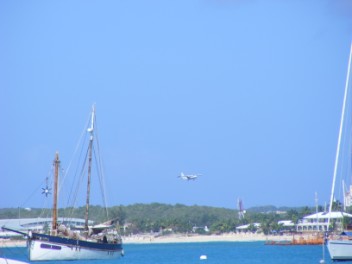
A range of hills straddle the island, the forest that once cloaked them has been felled with only scrub and secondary woodland remaining. Non-native species such as acacia dominate the plant communities. Development is meant to be restricted to low levels, but laws and designations are not generally enforced and houses creep up the hillsides.
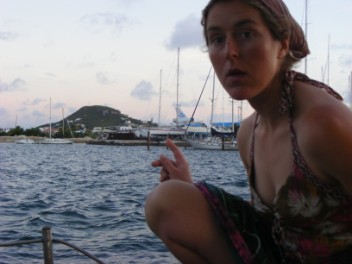
So that is the green doom. On the plus side, Sint Maarten is a melting pot of cultures. Brazilians, Venezuelans, Brits, Irish, French, Haitians, Americans, Australians, Swedes and Jamaicans queue in never ending traffic jams snaking along the island. (Great to fly passed on a bicycle down the outside lane!) The reason, Sint Maarten offers jobs- through tourism and development and the services they depend upon.
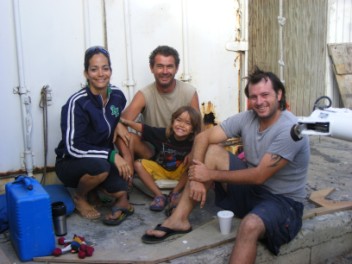
We remained in Philipsburg for a couple more days, in which Hol and Nick found themselves a ‘banana boat’ to voyage south to Dominica and Dan found a sailing team to race around the island with, for the classic boat festival. Thus ended our Lista Light odyssey with our three intrepid English companions. Although Dan did join us again after the races before disappearing for Dominica and who knows what crazy adventures…..?!
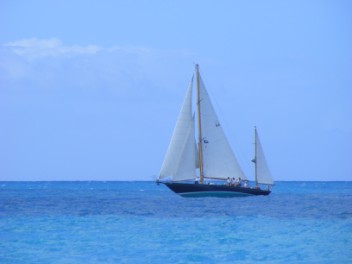
After leaving Philipsburg we sailed around the island to Simpson Bay and anchored Lista on the seaward side of the lagoon. Over the following days we cycled to and from the EPIC office, our bolt-hole of terra-firma normality as we ‘jenned’ up on the project. We also cycled c. 2miles to the neighbouring country- St Martin- lying on the Northern side of the tiny island. A department of France, Dave especially (as the Francophile who adores our Gaelic neighbours) and I found ourselves drawn to this less developed, slightly more natural and sophisticated side of the island. Incredibly, a couple of years ago, governance was such that police cars chasing criminals on the Dutch side of the island would grind to a halt at the French border and watch the criminals swagger off without having jurisdiction to pursue!
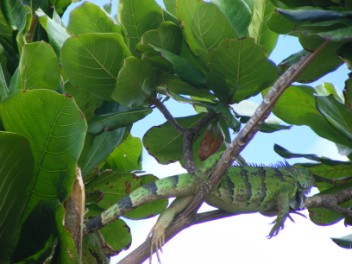
We met some great characters in Sint Martin on our biking-trailer escapades to collect supplies. Whilst hunting for a remote beach a woman (Katrine) bleated from her car whether we needed ‘aide´’. At first refusing, we soon found ourselves offered free kayaks to loan and the location of a beautiful beach. So off we cycled and eventually stumbled across the beach. Well, it wasn’t bad, but not quite the idyllic bolt hole we had envisaged. We picked our way to the very end of the white stretch of sand and buried ourselves under a tree in true anti-social British fashion.
Sorry - image not available (210bquit.jpg)
Our neighbours, however, did not have quite the same qualms. As Dave bandaged my leg (I had grated down a hill after catapulting off my bike on wet mud) they started to moan… Now before I go on, I had better fill you on the scene that greeted us on arrival to the beach. Families, children, couples all intermingled, some clothed others top or bottomless. A large gutted man stood above a clothed couple whom he chatted to, with his ‘old man’ dangling at their eye level. After much chat it appeared the he and his older, bit of stuff were our neighbours, as they wondered back to a beach chair a couple of metres from our noses. Before we could shake a leg, volumously girthed, drooping-assed guy was at it with his spelt lady a couple of metres from our face. Quite an apparition!
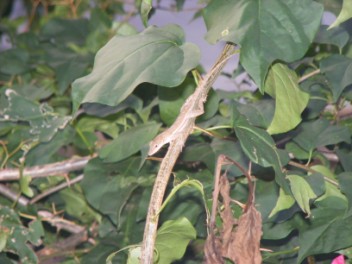
Back to Lista, after finally choosing a marina that would allow us to do the work on her, the job of pulling Lista out of her watery home onto the dry dock was to begin. This is a nasty procedure for Lista, captain and the ‘trouble and strife’. As soon as she is released from the salty arms of the seas onto dry land, the drying hands of the clock start to tick and her planks contract. The old gal is also a weighty registered 35 tonnes exerting a huge strain on her planks.
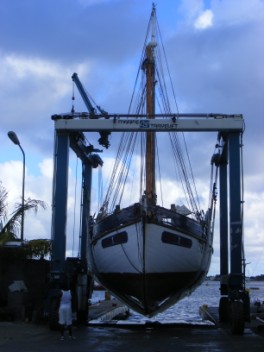
The first obstacle was raising her out of the water in the travel lift, ensuring that even pressure was maintained throughout her hull. This achieved, a full undercarriage power spray was inflicted on the old lady’s modesty. The main targets were the Goose Barnacles, her floating garden acquired crossing the Atlantic. The problem with such fascinating passengers is that they reduce her efficiency through the water and should we have to use the engine (heaven forbid) fuel consumption increases. We also needed to clear the way for the work needed on her undersides.
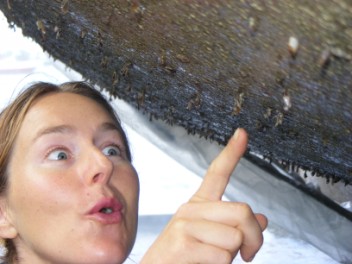
Thus, still dangling but newly washed, the next task was finding somewhere in the yard big enough to hold her beamy girth. (It appeared her colossal size had been underestimated, even with her 15ft bowsprit pulled in for fear of daggering rivals). Finally a site was found and ‘chocks’- wooden and metal chain supports were gathered to mount her upon. The nesting of our precious girl was the final heart wrenching procedure and we winced as her bulk creaked into her resting place.
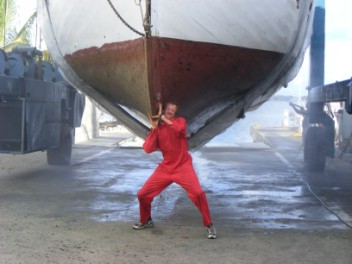
The next two weeks were filled with stripping Lista’s hull and filling holes. This involved Dave throwing away all the power tools and used a one inch scraper! It also contained much heartache trying to acquire the most environmentally sound anti-foul, a contradiction in terms. Boat owners apply toxic paint (anti-foul, often copper based) to ward off the ‘sea-garden’ that I described formally that winkle away at paint and boat. If it were only the worry of barnacles we would probably not cover Lista with the stuff, but there is another nemesis, Teredo Worm or Teredo navalis. Dave became intimately versed in the mechanics of this little critter, in fact, should you have any queries on said worm (actually a bi-valve) please do report into Prof. D.L.Lowrie. Teredo lurks in tropical waters and enters wooden structure (although it has been found as far afield as Germany which quashes any Tropical claims). The larvae (c.1cm across) then mow their way through the boat as if creating a new A1 motorway. Unfortunately, the adult is the size of a pin prick so if it does enter a boat, it cannot be detected. Such an attack would be the death nail to Lista and any survey work in the Caribbean.
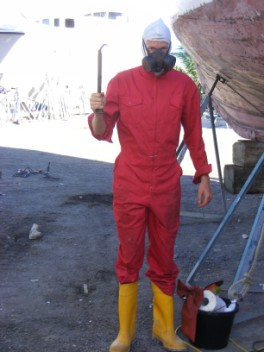
That was not the end of the Teredo story/lecture. During excavations Dave incredulously discovered that the very feared critters had in the past tunneled into Lista’s rudder and sacrificial keel. The tunnels were large and conclusive. The only consolation was that they were contained within the said areas and had not spread into the hull of the boat. This unwelcome discovery did, however, influence our anti-foul choice.
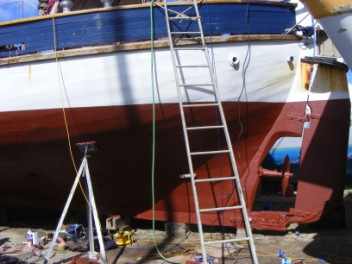
We at last procured some paint that was perhaps a little less offensive amongst a seriously toxic bunch and after the week of stripping and sanding we (primarily poor Dave) began slathering the various coats on. Now this was not the last curtain call for the anti-foul, our mission is about the environment and hopefully contributing to its conservation. So Dave came up with a plan to trial some alternative concoctions for future work and to inform other yachties. Thus a sacrificial piece of wood was attached with various paint treatments: ‘topside’ boat enamel, primer and chilli paint. We shall wait and see how many passengers will hop aboard….
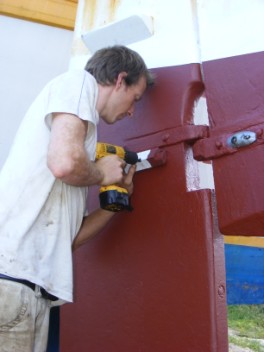
In the meantime Bobby’s Marina became home. We scaled a ladder each night to Lista’s lofty fortress and listened to Lance and Yvonne’s screeches for the pack of dogs that they had rescued from the streets. To all appearances, Lance was a steely South African, but he soon revealed the kindest spirit embracing people and animals alike. (He awoke each day at 4am and drove the streets gathering restaurant left-overs for his celebrity ‘muts’) Then there was the wonderful wonderer, Mason and his South African mates, Craig and Greg. Greg built his wooden boat completely from scratch amid protestations of his lunacy. A sculptor by trade, he whittled a floating castle with hand tools, that has withstood hurricanes and from which he sailed to the Caribbean with his wife from Cape Town.
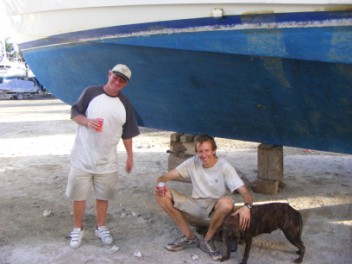
One night Dave, Mason and I hopped into the dinghy and with a wind-up torch to guide us wove our way across the lagoon to see Greg’s boat. She was the perfect floating home with a veranda like helm lit by the glowing cigarette lights of the two hunched figures. We sat and supped coffee and biscuits and chatted about the boat, birds, South Africa, sculpting, alcoholism, films, but mainly the environment and how we could make a difference and influence others to care. It was completely inspiring. Dave and I were among kindred soles ageing from Craig in his late thirties, to Mason in his forties and Greg in his fifties.
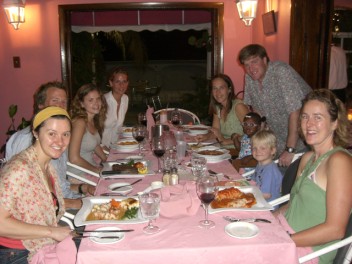
Then there was Charlie (South African), Nathalie (Venezuelan) and son Keenan who we chatted to during the day and who injected in us inspiration for Uruguay’s equitable culture, rich soil and deep rivers- endearing features to any sailor. Also Lofty the Swede and a guy from Hull who volleyed funny stories at us- one about his aversion to molasses after falling into a pit of it (understandable) and so many other friendly folk. Then there was Natalia and Adam (Brown), Cadence, Ella, Rueben and Jenna and life at the office amongst the Banana Quits, Green-fronted Hummingbirds and Iguanas who transformed a ‘cold’ island viewed from a solitary anchorage into a warm oasis.
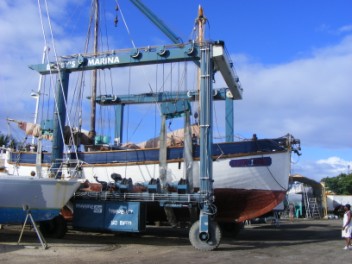
Finally, after two hard weeks of graft with Dave turning various shades of ‘paint’, Lista was ready for re-submersing and the start of the Lesser Antilles Seabird Breeding Atlas Project launched. With one Irish, two Americans and two Brits, Environmental Protection In the Caribbean (EPIC) crew began its journey. (That was: Emily, ‘the Irish’ or ‘Hurricane Emily’ as Dave has christened her! My friend from home who miraculously appeared one day, Megan our Ecologist Intern and chief kayaker from Seattle, Natalia Collier, President of EPIC who conceived the Project and was accompanying us until Saba and team Land-Lowrie).
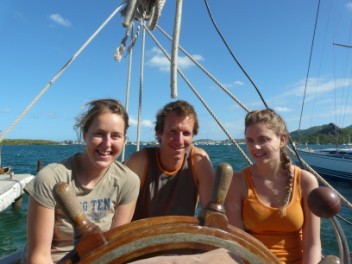
Back to previous section - Transatlantic Crossing
Forward to next section - Saba
This page hit Count : 5336
This is the Lista Light Website, for the travels of the sailing boat Lista Light
Click here for text-version of site